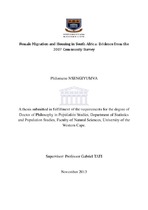| dc.description.abstract | Throughout the world, growing evidence suggests an increase of female migrants in migration streams. In the context of South Africa, women are not exempted from migration mechanisms. This new migration phenomenon is observed to influence housing accessibility among female migrants in the areas of destinations specifically in metropolitan and non-metropolitan areas of South Africa. Yet, little is known about the forms of housing tenure female migrants use to acquire a place to live in. The methods of housing acquisition of female migrants are still imperfectly documented. Moreover, it is not clear of how housing tenure differs among female migrants between metropolitan and non-metropolitan areas. Factors determining housing tenure and at what extent those factors are selective towards women in the places of destination are not properly elaborated in the existing body of knowledge. The aim of this research is to highlight the relationship between female migration and housing acquisition in South Africa by specifically looking at household headship in a gender perspective, and how housing acquisition differ between metropolitan and non-metropolitan areas of South Africa. It is assumed that inasmuch as migration is selective, so is a really differentiated selectivity of such places as metropolises and non-metropolises. This research makes use of the 2007 Community Survey secondary data derived from Statistics South Africa. The data analysis was carried out, first, by means of univariate analysis, cross-tabulation, and Chi-square statistical test for association. Logistic regression analysis was used in order to identify the determining factors of housing tenure among female migrants. The two groups of female migrants were considered namely: female migrants heading households and those who were not heading households. The units of analysis were metropolitan and non-metropolitan areas. This research focuses on internal female migration and housing in South Africa by examining different socio-demographic, socioeconomic, migratory, households, and housing attributes, by taking into account variables such as age, population group, marital status, level of education, just to name the few. By bringing together female migrants characteristics, migratory characteristics; and housing characteristics, the study found that female migrants heading households living in metropolitan areas are more likely to stay in rented dwellings, while those who were living in areas outside metropolitan (non-metropolitan areas) were highly represented in owned and fully paid dwellings. This study found further that, besides duration of residence, housing structure type, especially the availability of standalone housing type increases the likelihood of staying in owned and fully paid housing. This study concludes that, this new female migration stream creates more tension and pressure on housing provision in metropolitan areas in relation to non-metropolitan areas. Thus, policy makers should be aware of female migration and its impact in the housing sector in order to plan accordingly. | en_US |

